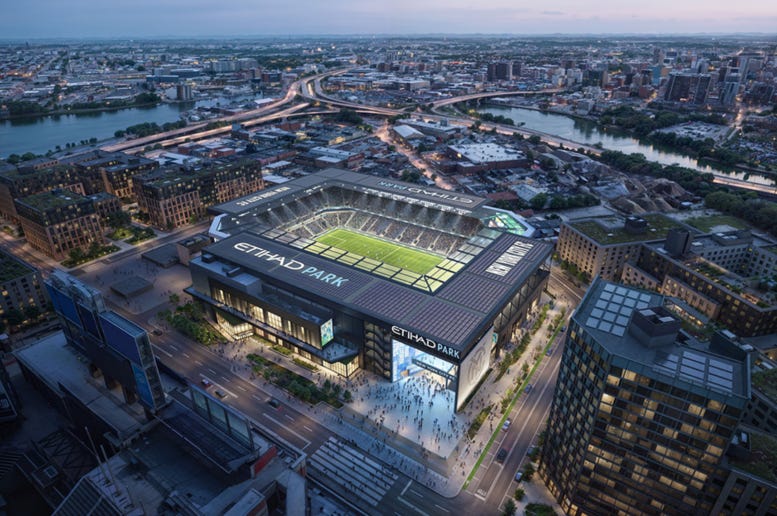Stadium City in the “Valley of Ashes”?
Words: Emily, NYC
When the New York City Council greenlit Etihad Park, a 25,000‐seat, privately financed, fully electric soccer stadium in Willets Point, riders of the 7 train cheered. Finally, NYCFC would call Queens home, its overwhelmingly diverse, working‐class borough. Politicians described the site as a former “Valley of Ashes” (the label designated to the area in The Great Gatsby), reborn through affordable housing, transit, and public space. But beneath the fanfare lies a troubling urban planning misstep that threatens to fracture Flushing’s fragile social makeup.
1. A “transit village” or a crowd magnet?
Willets Point is undeniably accessible, as it’s next to both the 7 train and Long Island Rail Road, adjacent to the New York Mets’ baseball team’s Citi Field. But turning that transit hub into a high-density event zone risks overwhelming local systems. On match days, tens of thousands will descend on a neighborhood already spilling onto narrow streets and transit platforms. That isn’t placemaking: it's a crowd funnel without sufficient diffusion. And what happens when something goes wrong and transit shuts down?
2. Affordable housing...with a catch
The promise of 2,500 “100% affordable” units is a headline, but according to the New York Times, buried deep lies a 49‐year land‐lease deal that costs the city upwards of $516 million in forgone property taxes. Effectively, Flushing’s tax base is funding a stadium that largely benefits a private club. And there’s no guarantee the housing will reach the lowest‐income households or that price pressure won't ripple into surrounding Flushing, displacing families already struggling.
3. Gentrification despite “affordable” labels
Even NYCFC supporters admit concern. As one has asked, “What are you doing for the neighborhoods surrounding that area?” Their worry remains true: any major redevelopment (stadium, hotel, retail) hurts Flushing’s culturally rich but economically vulnerable fabric. When the “new” Flushing erupts (and retail rents spike, apartments flip, tourism escalates), ethnically-anchored enclaves risk being replaced with wealthy newcomers.
4. Public space on private terms
The project touts 40,000 sq. ft of public open space and a “City Square” plaza. Such spaces can enrich communities, or serve as sanitized event-ticketed commons. The city’s Public Design Commission recommends measures to mitigate heat islands and ensure genuine public access. But will these spaces remain community‐driven, or controlled by stadium scheduling and security clearances? Flushing deserves parks, not plazas where sitting becomes “disruptive.”
5. Wildlife voids and environmental oversight
An often‐overlooked casualty of major projects is the existing informal ecology. A local colony of ~100 stray cats, descendants of the Shea Stadium-era pods, faces eviction with zero relocation plan. If a stadium plan ignores a felonious colony, how will it protect the wetlands, urban trees, and the mental health assets urban nature provides?
Better alternatives?
A more balanced redevelopment wouldn’t center a stadium. It would emphasize:
• Pocket parks and community gardens rather than crowded plazas
• Walkable mid‐rise housing spread across Willets Point, integrated with Flushing.
• Upgraded transit resilience, not corridors for event surges only.
• Environmental remediation that supports green infrastructure beyond basic cleanup.
• Equity‐backed housing, targeted to existing Queens families to avoid displacement.
A final whistle
Etihad Park will be shiny, revenue-fueled... on paper. But urban planners know placemaking is about daily life, not match-day magic. Flushing needs vibrant streets, affordable homes, and intact communities. A privately‐financed stadium with public cost may repair Willets Point’s “Valley of Ashes,” but it risks creating a “Valley of Guests.” The real champions of Queens deserve better than a trophy that glitters only on game day.
Etihad Park is a spectacular proposal. But it neglects integral urban planning principles: community-centered design, environmental stewardship, and long-term affordability. If the final pitch becomes stadium-first, community-last, Flushing loses, not wins.
******
Emily is a New York-based participant in Youth Media Forward: meet the New York New Jersey participants here
Further context:
NYCFC’s website about the Etihad Park stadium development.
NYCFC is part of City Football Group, along with Manchester City and several other clubs. The owners of City Football Group are (at the time of writing) 81% Abu Dhabi United Group, 18% Silver Lake (an American Private equity firm), and 1% the Chinese firms China Media Capital and CITIC Capital
This StoryMap by Kenny Zhou, “Transit Connectivity, Immigration and Development” provides further context on the neighborhood of Flushing, adjacent to Willets Point



